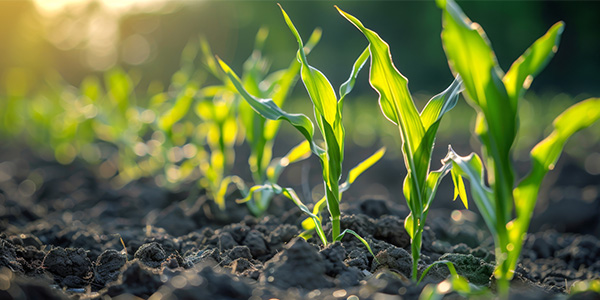AGRONOMICSUPPORT
YOU CAN TAKETO THE FIELD
Focus on Crop Health When Fighting Fusarium in Corn
Fusarium is a disease that strikes early, flies under the radar for much of the growing season and can cause headaches during harvest. While there’s no silver bullet for fusarium, there are steps you can take to protect your corn crop.
Key Points
- Fusarium infects crops early and can lead to harvestability and grain quality issues.
- There’s no silver bullet or genetic resistance to the fungus.
- Prioritizing plant health can help protect corn against infection or damage.
What is fusarium?
Fusarium affects corn and a multitude of other crops around the country. It’s caused by the fungus Fusarium verticillioides.
“Once it gets in the soil, it’s very difficult to get rid of,” says LG Seeds Agronomist Dan Mitchell. Fusarium infects crops early, and its ultimate impact hinges in part on the health of the crop.
Disease conditions and symptoms
Constant wet, cold weather early in the season makes corn more vulnerable to fusarium infection, as well as other diseases. “It’s rarely just one issue at a time when it comes to fusarium,” Mitchell explains. “Diseases tend to feed off of each other.”
Fusarium symptoms typically appear later in the season. “Generally, there’s a slow dieback of the lower leaves from the bottom up,” Mitchell explains. “There will be yellowing, and plants get a sickly look — almost like they’ve been frosted.”
A farmer might not be aware of any issue until stalk rot and/or ear rot appears late in the season. Depending on the timing of when it affects, Mitchell says the crown rot fusarium causes might lead to downed corn, issues with drydown and poor test weights.
Fusarium can also lead to ear rot and grain quality issues, such as fumonisin contamination. These mycotoxins can negatively impact the health of livestock and humans. “If you know you have a bad ear rot issue, get that grain harvested early and keep it separate so it doesn’t contaminate a whole bin,” Mitchell advises.
Planting considerations
Fusarium infections tend to happen amid cool, wet conditions early in the season. Therefore, Mitchell offers this advice: “Don’t plant too early into cold soils. Struggling plants are more vulnerable.”
Also avoid overly aggressive seeding populations. “High populations put more stress on the plant itself. Spacing plants farther apart allows for healthier, girthier stalks,” he explains. “A good rule of thumb may be to plant in the range of 30,000 to 35,000 seeds per acre, depending on the capacity of the soil.
“Using a seed treatment and doing all you can to keep that plant healthy can lower your odds of an infection and increase the odds your hybrids are able to tolerate the disease,” Mitchell continues. “The same can be said about fungicide use. They can help keep the corn plant healthy and protect it against other issues, giving it a better chance of tolerating fusarium.”
There is no pure genetic resistance to fusarium, Mitchell says, but some hybrids are naturally more tolerant thanks to characteristics like good early vigor or quick emergence. Using an insect-resistant trait can also help. “Anything you can do to protect the ear from insects or especially worms will help,” he continues. “Open wounds on a kernel are potential avenues for infection.”
Rotate crops and manage residue
Because fusarium overwinters, corn-on-corn acres and fields with limited or no tillage are at higher risk of infection. “Rotate to soybeans if you’re able,” Mitchell advises.
“If you have corn-on-corn acres, residue management will be especially important,” Mitchell says. “The residue needs to be tended to in the fall or even buried.”
Regarding no-till acres, Mitchell reminds it’s a management system with a unique set of concerns relative to conventional tillage systems. “Managing that residue is important to protecting against fusarium and other diseases,” he says.
“It’s been said that this is fusarium’s world, and we’re just living in it,” Mitchell says. “While there’s no magic potion for dealing with fusarium, farmers can limit the plant’s risk of infection and keep it healthy so it’s better able to tolerate an infection.”
For more support protecting your crops throughout the growing season, reach out to your local LG Seeds agronomist.





